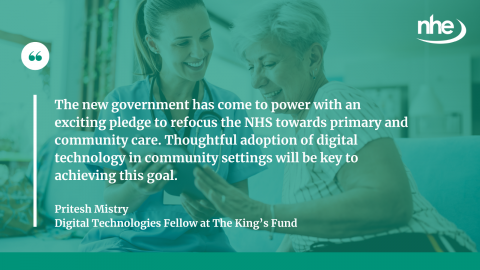Involving community healthcare staff in the development and implementation of digital technology can be the key to unlocking the new government’s ambition of a Neighbourhood Health Service and moving care closer to home, according to a new report from The King’s Fund.
Furthering the digital transformation agenda in general practice, pharmacies, community trusts, and care providers can help:
- reduce the number of patients accessing over-burdened hospitals;
- improve patient experience and outcomes; and
- people with ongoing care needs to live independent lives.
However, the report says that the current use of technology in community care mirrors the silos in the wider system, which is frustrating patients. One digitally confident person told the report: “I have five medical apps on my phone because the different hospitals have different systems. Why can’t I just have one?” According to The King’s Fund, this is a result of the funding and approach to digitalisation replicating organisational silos—and then the technology following suit.

The authors say that, instead of a standardised approach to digital technology, the NHS should start from patient’s existing capabilities and build digital support from there. “Underinvestment in digital technology in community settings has been holding back improvements to care and is frustrating staff and patients alike,” said Pritesh Mistry, who is a digital technologies fellow at The King’s Fund. Funnelling resource further upstream and bringing care further into the community were key parts of the Labour manifesto.
A lot of technology is currently designed for hospitals and rolled out in the community without any of the requisite engagement or understanding of the sector’s needs. Issues include connectivity, poor battery life, and heavy laptops. The electronic records software has been found to interrupt workflows, while district nurses occasionally need to duplicate tasks due to different systems being used by different organisations.
Mistry added: “As the country’s population ages and expectations around how to access health care services change, investment in these areas has become increasingly necessary, not optional.
“An initial step includes setting a national vision to guide local decisions, co-created with people and staff. This needs to be underpinned by boosted funding for innovation in community settings, and staff being given the time to develop the digital skills they need to embed improvements to digital systems.”
Image credit: iStock



















